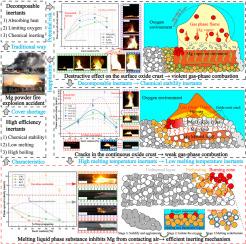Multiple effects of high efficiency solid inertants on fire hazard of the accumulated Mg dust layer
IF 9.4
1区 工程技术
Q1 ENERGY & FUELS
引用次数: 0
Abstract
Due to low melting and boiling points and extreme reactivity in the chemical reaction of Mg powder, inert powders that have a significant inerting effect on Mg dust clouds can cause significant combustion enhancement of the accumulated Mg dust layer. To circumvent this unforeseen fire hazard, this research selects five types of inertants that have been demonstrated to exert an inerting effect on metal dust clouds and possess a potential flame-retardant effect on Mg dust layers. This research aims to investigate the effect of inert powders on Mg dust layers to identify an efficient inerting mechanism for Mg dust layers. The results indicate that the selection of inertants for Mg dust must be based on a comprehensive evaluation of their physical and chemical properties. The presence of substances with strong decomposition and decomposition products that readily produce gases will destroy the oxide crust on the surface of the accumulated Mg dust layer, thereby causing violent gas-phase combustion. In the case of highly chemically stable substances, the melting point is of primary importance. The formation of cracks in the oxide crust is also a consequence of the higher melting point of inertants, resulting in a combustion enhancement of the mixed dust layer. Inertants with a low melting point and a high boiling point demonstrate a high degree of inerting efficiency for Mg dust layers. The melting of the inert substances forms a liquid film, which prevents the Mg powder from coming into contact with the air surrounding and within the combustion zone. The results of this research are both instructive and valuable for preventing explosions in the process industry involving metal dust materials.

高效固体惰性剂对累积镁粉尘层火灾危险的多重影响
由于镁粉的熔点和沸点较低,且在化学反应中具有极强的反应性,因此对镁尘云具有显著惰性作用的惰性粉末可能会导致积聚的镁尘层燃烧加剧。为了规避这种不可预见的火灾隐患,本研究选择了五种已被证实对金属粉尘云具有惰性作用,并对镁粉尘层具有潜在阻燃效果的惰性粉末。本研究旨在调查惰性粉末对镁粉尘层的影响,以确定镁粉尘层的有效惰性机制。结果表明,镁粉尘惰性剂的选择必须基于对其物理和化学特性的综合评估。具有强分解性和分解产物容易产生气体的物质会破坏积聚镁尘层表面的氧化物结壳,从而引起剧烈的气相燃烧。对于化学性质高度稳定的物质,熔点至关重要。氧化皮裂缝的形成也是惰性物质熔点较高的结果,从而导致混合粉尘层的燃烧增强。熔点低、沸点高的惰性物质对镁粉尘层具有很高的惰性效率。惰性物质熔化后会形成一层液膜,阻止镁粉与燃烧区周围和内部的空气接触。这项研究的结果对于防止加工工业中涉及金属粉尘材料的爆炸既有指导意义,也很有价值。
本文章由计算机程序翻译,如有差异,请以英文原文为准。
求助全文
约1分钟内获得全文
求助全文
来源期刊

Energy
工程技术-能源与燃料
CiteScore
15.30
自引率
14.40%
发文量
0
审稿时长
14.2 weeks
期刊介绍:
Energy is a multidisciplinary, international journal that publishes research and analysis in the field of energy engineering. Our aim is to become a leading peer-reviewed platform and a trusted source of information for energy-related topics.
The journal covers a range of areas including mechanical engineering, thermal sciences, and energy analysis. We are particularly interested in research on energy modelling, prediction, integrated energy systems, planning, and management.
Additionally, we welcome papers on energy conservation, efficiency, biomass and bioenergy, renewable energy, electricity supply and demand, energy storage, buildings, and economic and policy issues. These topics should align with our broader multidisciplinary focus.
 求助内容:
求助内容: 应助结果提醒方式:
应助结果提醒方式:


